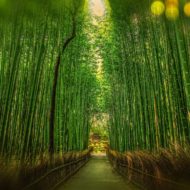道沖而用之 有弗盈也 潚呵 始萬物之宗
[dao4] [chong1] [er2] [yong4] [zhi1] [you3] [fu2] [ying2] [ye3] [xiao1] [a1] [shi3] [wan4] [wu4] [zhi1] [zong1]
The Dao is poured from and used, [but] it is not filled, it is vast, it is ancestor to the start of the Ten Thousand Things
「道」沖,而用之或不盈。淵兮,似萬物之宗﹔
「[dao4]」 [chong1], [er2] [yong4] [zhi1] [huo4] [bu4] [ying2]。 [yuan1] [xi1], [si4] [wan4] [wu4] [zhi1] [zong1]
“The Dao” is poured from and used, [but] it it is not filled. It is vast, it seems to be ancestor to the Ten Thousand Things
The Dao flows and is “used”, but never runs out and it is never refilled as it is inexhaustible. It runs through everything and is the origin of everything. The Dao is the originator for creation itself. The only difference between the translations is that the first implies that the Dao sets in motion creation and the events of creation, while the second is a bit less direct.
銼其銳 解其紛 和其光 同其塵
[cuo4] [qi2] [rui4] [jie3] [qi2] [fen1] [he2] [qi2] [guang1] [tong2] [qi2] [chen2]
[It] blunts sharpness, untangles knots, harmonizes light, brings together dust
挫其銳,解其紛,和其光,同其塵﹔
[cuo4] [qi2] [rui4], [jie3] [qi2] [fen1], [he2] [qi2] [guang1] , [tong2] [qi2] [chen2]﹔
[It] blunts sharpness, untangles knots, harmonizes light, brings together dust;
“The Dao blunts [or files down] sharpness.” The Dao originates creation as well as action, both of which dull down sharpness. Time implies action, and actions gradually change the landscape. The organic motions of the environment will wear a mountain down to a hill and down to a field with enough time, and enough usage will dull the edge of a blade. This is reiterated by it untangling knots, albeit in a more positive light. It can bring chaos or order.
When the Dao harmonizes light, it can also be read as bringing peace to light, or uniting light to some degree. I take this to mean that it this both means it can intensify light by making it united with other light, as well as make it “calmer” which can reduce the harshness of glare. Light can be intensified to be blinding, or it can be softened to reduce glare. The changes are neutral overall, but can be positive or negative depending on the frame of reference.
Dust to dust; ashes to ashes is an old saying that implies the cyclical nature of creation over time. This saying permeates throughout most cultures in some form or another. The Dao is the force which turns the leftover, castoff bits of dust and ash back into something new. It is the force through which things are broken down and the force, through which they are reformed.
湛呵 似或存
[zhan4] [a1] [si4] [huo4] [cun2]
It is [so] deep, it seems to [always] have something left
湛兮似或存。
[zhan4] [xi1] [si4] [huo4] [cun2]。
It is [so] deep, it seems to [always] have something left
The Dao is inexhaustible. As the Dao flows, so it will always flow. It cannot run out, it cannot be diminished, it is unending. The Dao is a vast ocean beyond the depths of our comprehension or any comprehension. This section reiterates what we have previously said just to drive the point home.
吾不知誰子也 象帝之先
[wu2] [bu4] [zhi1] [shei2] [zi3] [ye3] [xiang4] [di4] [zhi1] [xian1]
I do not know whose child it is, it seems to be prior to the gods
吾不知誰之子?象帝之先。
[wu2] [bu4] [zhi1] [shei2] [zhi1] [zi3]? [xiang4] [di4] [zhi1] [xian1]。
I do not know whose child it is? It seems to be prior to the gods
This section basically just implies that the Dao is older than the gods and creation itself and of an indeterminate age and origin. The Dao doesn’t come from anyone or anything, it just is. It is the source of existence, action, creation, and predates the cosmic forces of the universe.
This entire chapter is just a commentary on the Dao stating that it is unending, effectively timeless, and beyond comprehension. It is the force of creation and destruction. It is the force of change and action. The Dao is beyond the gods and its origin is unknowable and incomprehensible.
